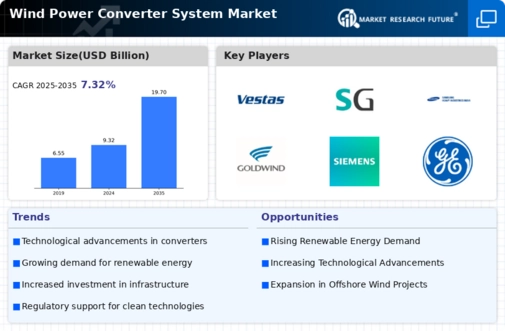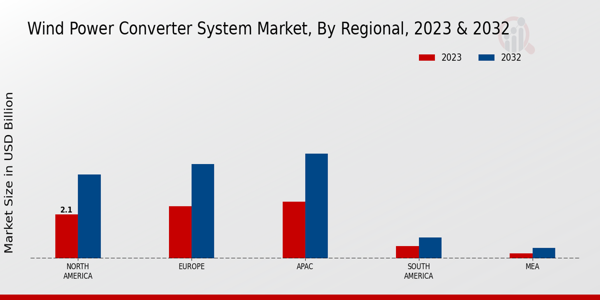Growing Energy Needs
The escalating global energy demand significantly impacts the Global Wind Power Converter System Market Industry. As populations grow and economies develop, the need for sustainable and reliable energy sources becomes increasingly critical. Wind energy, being one of the most abundant renewable resources, offers a viable solution to meet this demand. Countries are increasingly recognizing the potential of wind power to provide clean energy while reducing dependence on fossil fuels. This growing energy need is expected to drive investments in wind power infrastructure, further boosting the demand for wind power converters as essential components in the energy transition.
Market Growth Projections
The Global Wind Power Converter System Market Industry is poised for substantial growth, with projections indicating a market size of 9.32 USD Billion in 2024 and an anticipated increase to 19.7 USD Billion by 2035. This growth trajectory suggests a compound annual growth rate (CAGR) of 7.06% from 2025 to 2035, reflecting the increasing adoption of wind energy technologies worldwide. The market's expansion is driven by various factors, including technological advancements, government policies, and rising energy demands. As the world shifts towards sustainable energy solutions, the wind power converter market is likely to play a crucial role in facilitating this transition.
Technological Advancements
Technological innovations in wind power converter systems significantly influence the Global Wind Power Converter System Market Industry. Advances in power electronics, control systems, and grid integration technologies enhance the efficiency and reliability of wind energy conversion. For example, the development of high-efficiency inverters and advanced control algorithms allows for better energy management and integration with existing power grids. These innovations not only improve the performance of wind power systems but also reduce operational costs, making wind energy more competitive. As a result, the market is expected to grow at a CAGR of 7.06% from 2025 to 2035, indicating a robust future for wind power technologies.
Government Incentives and Policies
Government incentives and supportive policies play a pivotal role in shaping the Global Wind Power Converter System Market Industry. Many countries offer financial incentives, such as tax credits and grants, to promote the installation of wind energy systems. For instance, the United States has implemented the Production Tax Credit, which encourages investment in wind energy projects. Such policies not only stimulate market growth but also attract private investments, thereby accelerating the deployment of wind power converters. This supportive regulatory environment is likely to sustain the market's expansion, contributing to the anticipated growth to 19.7 USD Billion by 2035.
Rising Demand for Renewable Energy
The increasing global emphasis on renewable energy sources drives the Global Wind Power Converter System Market Industry. Countries are setting ambitious targets for reducing carbon emissions, which necessitates a shift towards cleaner energy solutions. For instance, the European Union aims to achieve climate neutrality by 2050, which includes substantial investments in wind energy infrastructure. This transition is expected to enhance the demand for wind power converters, as they play a crucial role in converting wind energy into usable electricity. The market is projected to reach 9.32 USD Billion by 2024, reflecting the growing commitment to sustainable energy solutions.
Environmental Concerns and Climate Change
Heightened awareness of environmental issues and climate change drives the Global Wind Power Converter System Market Industry. As the impacts of climate change become more pronounced, there is a collective push towards reducing greenhouse gas emissions. Wind energy is recognized as a key player in this transition, providing a clean alternative to traditional energy sources. The urgency to address climate change has led to increased investments in renewable energy technologies, including wind power converters. This trend is likely to continue, as stakeholders prioritize sustainability and environmental stewardship, thereby fostering market growth.












